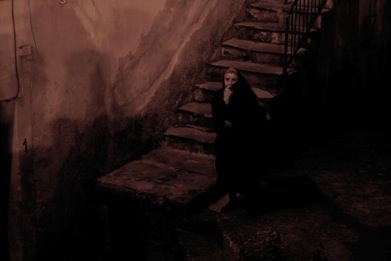TARANTISM:
DANCE, POSSESSION AND EXORCISM IN SOUTHERN ITALY
(excerpt- click HERE for complete version)
One summer years ago, during one of my stays in Calabria, a region in the
south of Italy where my mother comes from and where I have spent most of my childhood growing up and daydreaming, I remember being invited for dinner at my best friend’s home. Her family are a humble and strong
nucleus of hard working folk, constantly pushing back against a difficult life
of economic hardships and social struggles, against the backdrop of a tiny
insular village straddled somewhere between the mountain and the sea, with its tantalizing, vast horizon always out of reach.
I remember the table laid with paper plates and paper napkins, as is
customary amongst friends and family on hot summer nights, with the
exception for one seat, at the head of the table, that was laid with a ceramic
plate and a thick cotton napkin rolled up neatly inside a napkin holder.
That was the seat reserved for the head of the family, father and
breadwinner.
As we started eating food, as always overwhelming in both taste and
quantity, I noticed that my friend’s grandmother was sitting away from the
table, facing a corner with her black-clad body hunched and turned away
from us. When I asked my friend why she sat there alone, she replied saying that it was her usual attempt, as always in her life, not to be of bother. We both giggled, with the melancholy laughter that comes from recognition and deep understanding of a reality that we have both experienced, in different but ultimately similar intimacy: me as the only grandchild dipping sporadically in and out of what felt to me, growing up, as an archaic order slightly removed from my other, more emancipated life in Rome- and her as the trapped lunatic, the black sheep of the family always tearing at the stifling order of things with the long, sharp fingernails of her inquisitive mind, challenging and subverting the tranquility of her environment with her piercing restless gaze that always saw too much, with her tongue that always spoke too much and that, in time, transformed her into the visible sore in the fabric of her family, the threat to the order, the loose cannon that might erupt and shatter everything.
This is not an unfamiliar trait in southern Italian households; I grew up
watching my own mother, a modern, independent woman born of
respectable and educated upper class parents, a doctor in the lineage of
doctors, struggle daily with her expected role in life even when several
hundred miles separated her from her father and her South. Her anxiety
and disquiet was a constant weight on my grandfather, himself the cause of
most of it with his intrusive attempt to organize and “resolve” her life, and in particular what he felt to be a chronic melancholia that had plagued her
since early childhood.
My grandmother, a stunningly beautiful and smart woman of Albanian
heritage, once charming and boisterous, had given up on her desires and
hopes supplanted by a life of controlled and precariously managed
disappointment in her role of “woman of the house”. Sometimes, when
deep in conversation with her, I remember her morale lifting, returning her
to the lively and eccentric personality that still simmered somewhere deep
within her. Every year, usually at Christmas, these tensions would erupt
violently, playing out according to repetitive and familiar patterns year after
year, causing pain, fear and instability, but also, crucially, clearing the air, as
a storm might do, and granting a few hours of shared peace.
Repression, compromise, physical and emotional hardship, and above all a
capitulation to an order above removed from any personal compassion,
dictated by the rules and mores of a hegemonic order that often took no
notice of the specific hardships of individuals and their personal traumas,
especially those most humble or vulnerable (and women were both), was the backdrop against which Tarantism developed and played out for over 9
centuries.


